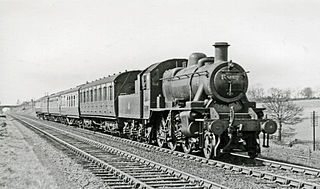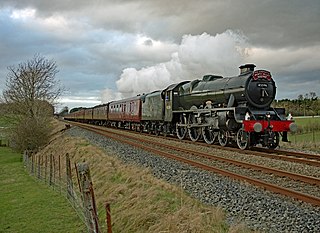
The Rainhill trials was an important competition run from the 6 to 14 October 1829, to test George Stephenson's argument that locomotives would have the best motive power for the then nearly-completed Liverpool and Manchester Railway (L&MR). Ten locomotives were entered, of which five were able to compete, running along a 1 mile (1.6 km) length of level track at Rainhill, in Lancashire.

The London, Midland and Scottish Railway (LMS) Princess Royal Class is a class of express passenger 4-6-2 steam locomotive designed by William Stanier. Twelve examples were built at Crewe Works, between 1933 and 1935, for use on the West Coast Main Line. Two are preserved.
The London, Midland and Scottish Railway had the largest stock of steam locomotives of any of the 'Big Four' Grouping, i.e. pre-Nationalisation railway companies in the UK. Despite early troubles arising from factions within the new company, the LMS went on to build some very successful designs; many lasted until the end of steam traction on British Railways in 1968. For an explanation of numbering and classification, see British Rail locomotive and multiple unit numbering and classification.

The London, Midland and Scottish Railway (LMS) Jubilee Class is a class of steam locomotive designed for main line passenger work. 191 locomotives were built between 1934 and 1936. They were built concurrently with the similar looking LMS Stanier Class 5 4-6-0. They were nicknamed Red Staniers and Jubs.

The steam locomotives of British Railways were used by British Railways over the period 1948–1968. The vast majority of these were inherited from its four constituent companies, the "Big Four".

The London, Midland and Scottish Railway (LMS) Stanier Class 5 4-6-0, commonly known as the Black Five, is a class of 4-6-0 steam locomotives. It was introduced by William Stanier and built between 1934 and 1951, of which 842 were built and were numbered 4658-5499. Several members of the class survived to the last day of steam on British Railways in 1968, and eighteen are preserved.
The Great Western Railway purchased two diesel shunters, and ordered a further seven immediately prior to Nationalisation, which were delivered to British Rail in 1948–49. The two shunters used by the GWR were numbered 1 and 2, while a series commencing at 501 was planned for the new locomotives ordered in the 1940s. British Rail renumbered both its inherited and new locomotives in a series commencing from 15100.

The Patriot Class was a class of 52 express passenger steam locomotives built for the London Midland and Scottish Railway. The first locomotive of the class was built in 1930 and the last in 1934. The class was based on the chassis of the Royal Scot combined with the boiler from Large Claughtons earning them the nickname Baby Scots. A total of 18 were rebuilt to create the LMS Rebuilt Patriot Class between 1946 and 1948; thereafter those not subjected to rebuilding were often referred to as the Unrebuilt Patriot Class. These remaining 34 unrebuilt engines were withdrawn between 1960 and 1962.

The London, Midland and Scottish Railway (LMS) Ivatt Class 2 2-6-0 is a class of steam locomotive designed for light mixed traffic.

Crewe Works is a British railway engineering facility located in the town of Crewe, Cheshire. The works, which was originally opened by the Grand Junction Railway in March 1843, employed around 7,000 to 8,000 workers at its peak. In the 1980s much of the engineering works were closed. Most of the site has been redeveloped, but the remaining parts are owned and operated by Alstom.

LMS Princess Coronation Class 46233 Duchess of Sutherland is a steam locomotive built in 1938 for the London, Midland and Scottish Railway (LMS) at Crewe Works to a design by William Stanier. It is a 4-6-2 Pacific locomotive built as part of the LMS Coronation Class for its express passenger services, including the Royal Scot service from London to Glasgow.

London, Midland and Scottish Railway (LMS) Jubilee Class No. 5690Leander is a preserved British steam locomotive.

London, Midland and Scottish Railway (LMS) Jubilee Class 5596Bahamas is a preserved British steam locomotive. It is named after The Bahamas.

6201 Princess Elizabeth is a preserved steam locomotive in England. It is one of two preserved LMS Princess Royal Class; the other being 46203 Princess Margaret Rose.

London, Midland and Scottish Railway (LMS) Jubilee Class No. 5699Galatea is a preserved British steam locomotive.
Perseverance may refer to:

The London and North Western Railway (LNWR) Prince of Wales Class was a class of express passenger locomotive. It was in effect, a superheated version of the Experiment Class 4-6-0.

The London and North Western Railway (LNWR) George the Fifth Class was a class of 4-4-0 passenger steam locomotive.

The London, Midland and Scottish Railway (LMS) Rebuilt Royal Scot Class is a class of 4-6-0 steam locomotives. 70 members of this class were rebuilt by the LMS and its successor British Railways (BR) from LMS Royal Scot Class engines by the replacement of their life expired parallel boilers with a type 2A boiler over the period 1943–1955.. They were the second class to be rebuilt with type-2 boilers, after the rebuilding of British Legion and the Jubilee Class.

The London, Midland and Scottish Railway (LMS) Rebuilt Jubilee Class consisted of two 4-6-0 steam locomotives.
This page is based on this
Wikipedia article Text is available under the
CC BY-SA 4.0 license; additional terms may apply.
Images, videos and audio are available under their respective licenses.
















